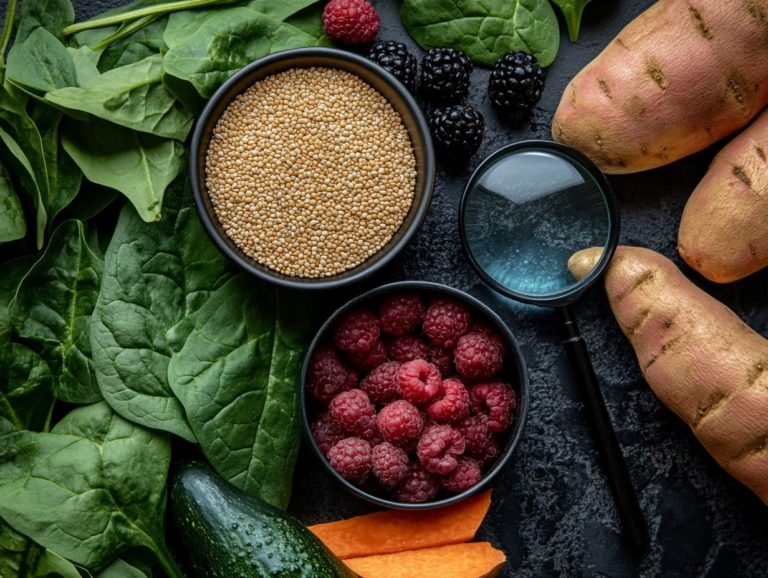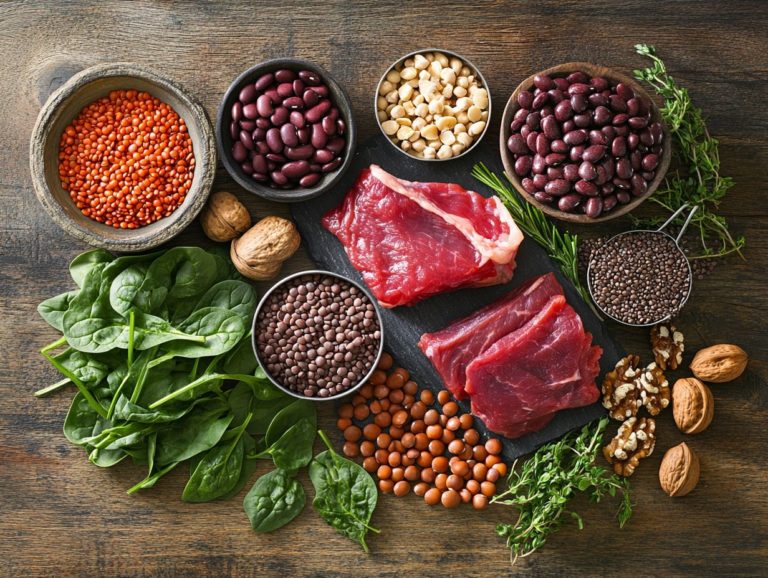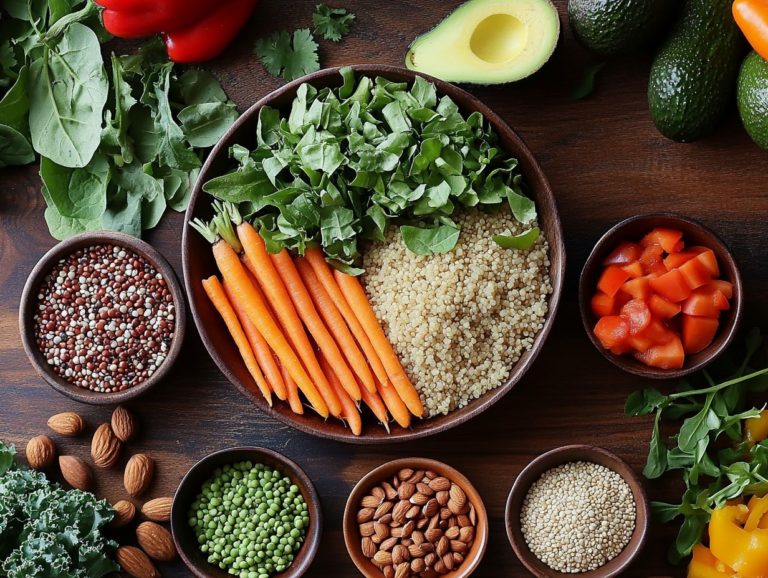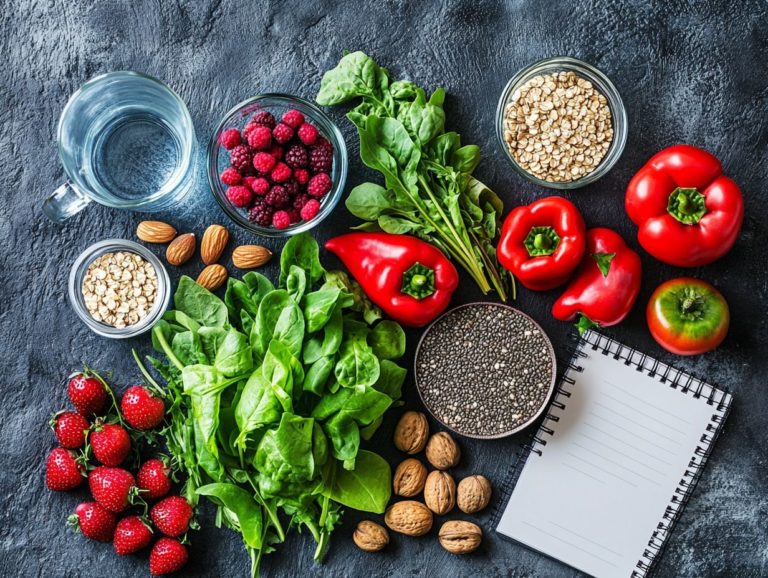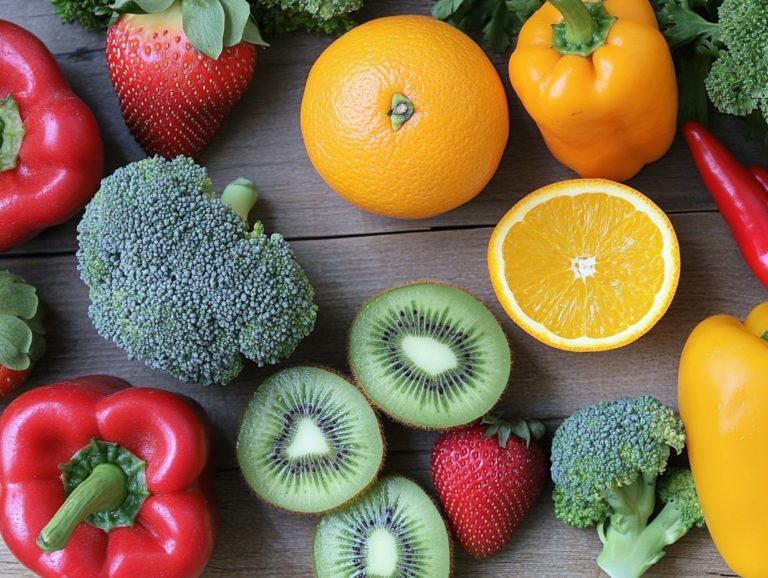Top 5 Foods for Boosting Your Magnesium Levels
Magnesium is an essential mineral that plays a crucial role in many bodily functions, from energy production to maintaining optimal muscle and nerve health. Despite its significance, it s surprising how many individuals fall short of their magnesium needs.
To easily elevate your diet, consider incorporating the top five magnesium-rich foods:
- dark leafy greens
- avocados
- nuts and seeds
- whole grains
- legumes
In this article, you ll uncover the myriad benefits of magnesium for your body, the signs of deficiency, and daily intake recommendations. You ll also find practical tips for seamlessly integrating these nutritious foods into your meals.
Discover how to enhance your magnesium levels and elevate your overall well-being!
Contents
- Key Takeaways:
- 1. Dark Leafy Greens
- 2. Avocado
- 3. Nuts and Seeds
- 4. Whole Grains
- 5. Legumes
- How Does Magnesium Benefit the Body?
- What Are the Symptoms of Magnesium Deficiency?
- What Are the Different Types of Magnesium-Rich Foods?
- How Can a Balanced Diet Help with Magnesium Intake?
- What Is the Recommended Daily Intake of Magnesium?
- What Are the Possible Side Effects of Too Much Magnesium?
- How Can One Incorporate These Foods into Their Diet?
- What Are Some Other Ways to Boost Magnesium Levels?
- What Are the Best Sources of Magnesium for Vegetarians and Vegans?
- Can Supplements Be Used to Increase Magnesium Levels?
- What Are the Benefits of Having Optimal Magnesium Levels?
- Frequently Asked Questions
- Want to know the best foods to boost your magnesium levels?
- Why is magnesium important for our bodies?
- How can a deficiency in magnesium affect our health?
- What makes dark leafy greens a top food for boosting magnesium levels?
- Why are nuts and seeds recommended for increasing magnesium intake?
- Can incorporating these foods into our diet provide enough magnesium on its own?
Key Takeaways:
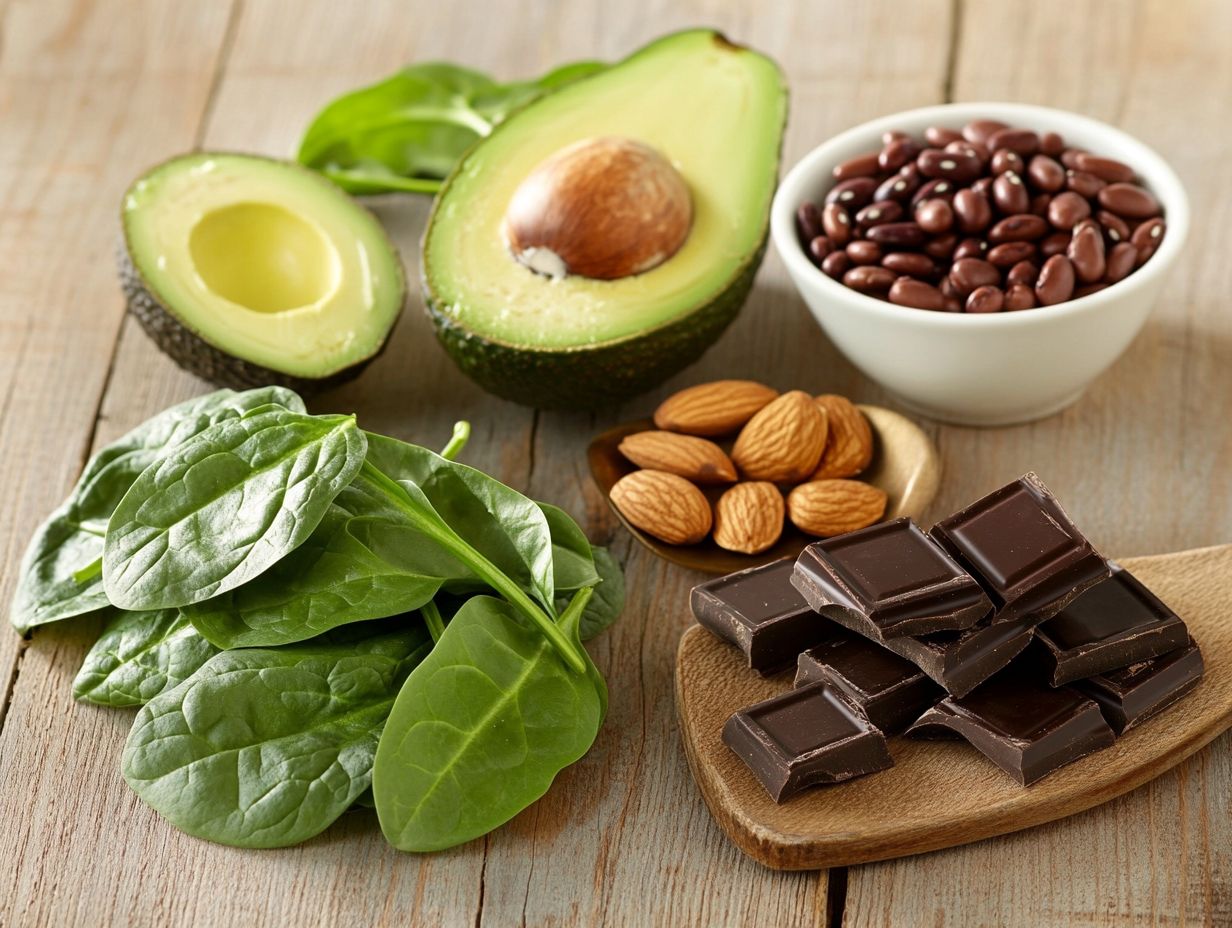
Incorporating dark leafy greens into your diet can boost your magnesium levels and improve overall health. Avocados are a delicious and versatile source of magnesium that can help prevent symptoms of deficiency. Nuts, seeds, whole grains, and legumes are all rich in magnesium and can be easily incorporated into a balanced diet.
Start your journey to better health today!
1. Dark Leafy Greens
Dark leafy greens, like spinach and kale, aren t just a feast for the eyes; they re also a powerhouse of nutrition. They re loaded with magnesium, which plays a pivotal role in various bodily functions, from maintaining your heart rhythm to supporting muscle contractions and regulating blood pressure.
By incorporating these greens into your diet, you can significantly elevate your magnesium levels and bolster your overall well-being.
Other dark leafy greens, such as Swiss chard and collard greens, also deliver an impressive magnesium boost. A single cup of cooked Swiss chard offers around 150 mg of this essential mineral. The benefits of these greens extend far beyond magnesium; they support heart health by enhancing the health of blood vessels and reducing inflammation.
Your bone health will also benefit, as their high vitamin K content works synergistically with magnesium to promote bone density. To get the most out of your greens, enjoy 1-2 cups daily. Whether tossed in salads, saut ed with garlic, or blended into smoothies, they offer versatility in your meals. Lightly steaming or cooking them can further enhance nutrient availability, making them even more beneficial for your health.
2. Avocado
Avocado isn t just a tasty fruit; it s a nutrient powerhouse, packed with magnesium an essential mineral that fuels energy production and supports optimal body functions. This makes it an exceptional addition to your healthy diet.
But wait, there s more! Beyond magnesium, avocados are loaded with other vital nutrients, such as potassium and heart-healthy fats. These elements work together to enhance heart health by regulating blood pressure and improving cholesterol levels.
Incorporating this creamy delight into your meals can be a smart move for weight management, thanks to its satiating properties. As a source of fiber, avocados help you feel fuller for longer, potentially leading to reduced caloric intake. This impressive nutrient profile not only supports a balanced diet but also promotes overall wellness, making avocados a wise choice for anyone who prioritizes health.
3. Nuts and Seeds
Nuts and seeds are not just delightful snacks; they’re also powerhouses of magnesium, a mineral crucial for heart health, muscle function, and overall well-being.
They offer a convenient way to elevate your magnesium intake effortlessly. Among the array of options, almonds truly shine as an exceptional choice, delivering a generous amount of magnesium per serving. This can be particularly beneficial for lowering blood pressure and enhancing your overall cardiac function.
Don t overlook pumpkin seeds, either; they re brimming with this essential mineral and also provide zinc, which plays a significant role in supporting your immune health.
By incorporating these nutrient-packed foods into your diet, you can significantly aid in the prevention of heart disease while also promoting metabolic functions, making them a smart addition to your snacking routine.
4. Whole Grains
Whole grains are vital for your health. They provide magnesium that helps regulate blood pressure and support digestion.
Foods like quinoa, brown rice, and barley are not only rich in magnesium but also packed with fiber and essential vitamins. These nutrients promote gut health.
Including whole grains in your meals can help maintain a balanced gut microbiome, which is crucial for optimal digestion. They fit well into various dietary patterns.
Whether you re following a plant-based lifestyle, the Mediterranean diet, or gluten-free choices, whole grains can seamlessly enhance your meals. Grains like farro or buckwheat elevate your nutrient intake while ensuring your dishes remain satisfying and delicious.
Embracing a diverse range of whole grains is a powerful strategy for boosting your magnesium levels and enhancing your overall well-being.
5. Legumes
Beans and lentils are great sources of magnesium. They are packed with protein and fiber that contribute to a balanced diet.
Consider varieties like chickpeas, black beans, and kidney beans. Each brings unique flavors and textures to your cooking.
The impressive magnesium content in legumes plays a crucial role in maintaining muscle and nerve function. This makes them an essential addition to your meals.
By incorporating these nutrient-dense foods into your cooking, you can significantly elevate your nutrient intake. Legumes not only provide essential vitamins and minerals but also positively impact cardiovascular health.
They help lower cholesterol levels and maintain healthy blood pressure, promoting your overall well-being.
How Does Magnesium Benefit the Body?
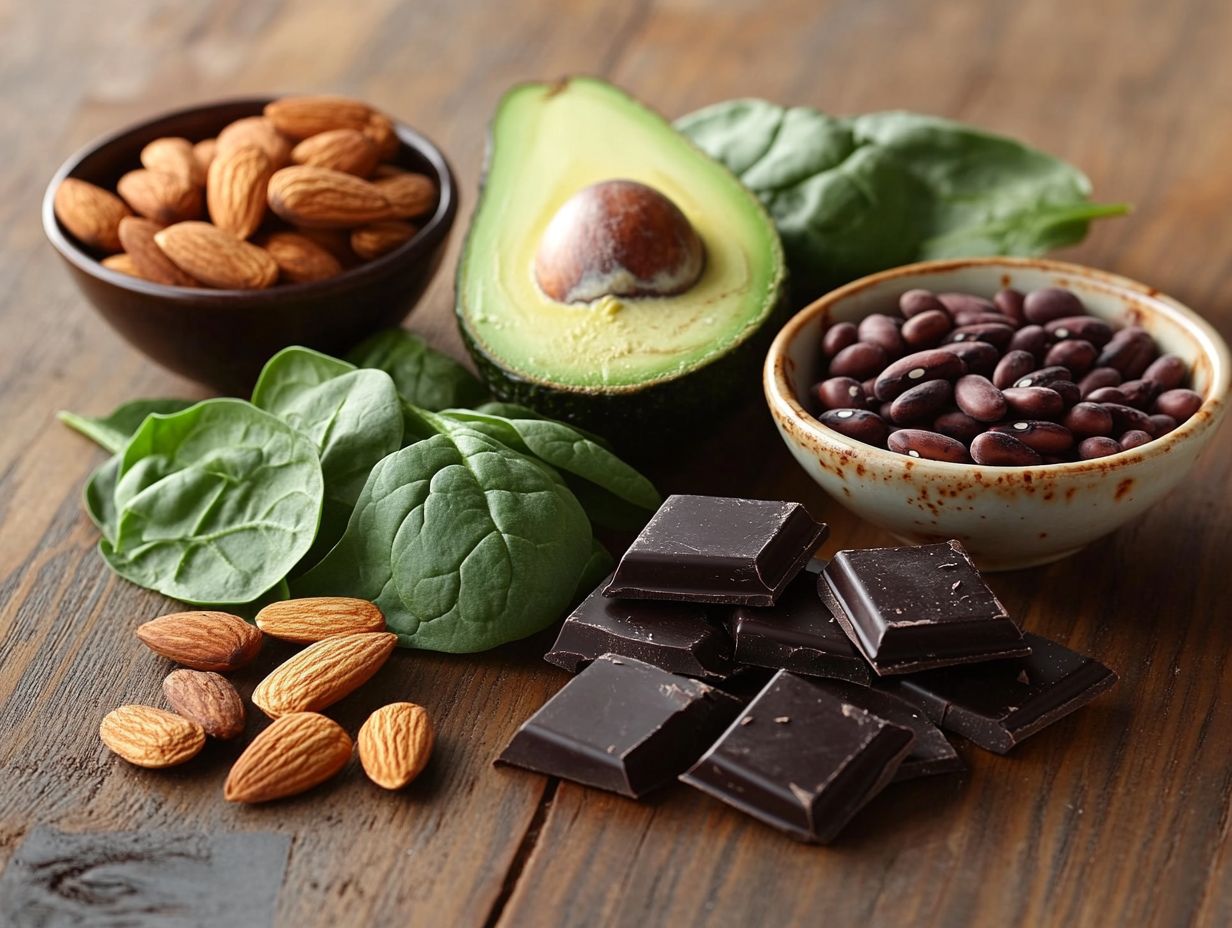
Magnesium is crucial for many body functions. It regulates heart rhythm, supports muscle contractions, and helps produce energy.
These functions are vital for maintaining a healthy lifestyle and meeting your body’s demands. Magnesium also helps maintain healthy blood pressure levels.
It acts as a natural calcium channel blocker, relaxing muscles and reducing tension in blood vessels. This can lower your risk of heart disease.
Research suggests that getting enough magnesium may prevent hypertension and cardiovascular complications. Magnesium also influences how your body utilizes glucose, which is important in preventing type 2 diabetes.
A deficiency in magnesium can lead to health issues such as muscle cramps, fatigue, and an increased risk of arrhythmias. Ensuring adequate magnesium in your diet supports your overall health and well-being.
What Are the Symptoms of Magnesium Deficiency?
A lack of magnesium can cause fatigue and muscle cramps. It may also lead to mental health issues that affect your well-being.
This deficiency can increase your risk of chronic conditions like heart disease and diabetes. You might experience insomnia, headaches, and digestive problems.
A limited intake of magnesium has been linked to weight gain and obesity. It plays a crucial role in regulating energy metabolism.
Additionally, deficiency can elevate stress levels and anxiety, creating a cycle that impacts both mental and physical health. Understanding these implications is essential for anyone looking to improve their lifestyle.
Take charge of your health by ensuring you have enough magnesium in your diet!
What Are the Different Types of Magnesium-Rich Foods?
You ll find a delightful array of magnesium-rich foods at your fingertips. From fiber-packed plant options like legumes and dark leafy greens to indulgent treats like dark chocolate, it’s simple to incorporate this essential nutrient into your daily meals.
Take whole grains, for example. Quinoa and brown rice stand out as stellar sources, perfect for creating hearty salads or delicious side dishes.
Nuts and seeds, such as almonds and pumpkin seeds, can elevate your breakfast. Just sprinkle them over yogurt or oatmeal for that extra nutritional punch.
And let s not overlook fatty fish like salmon. It delivers healthy fats and is brimming with magnesium ideal for a satisfying dinner.
By thoughtfully incorporating these foods into your meals, you boost your nutrient intake while enhancing the flavor and diversity of your diet.
How Can a Balanced Diet Help with Magnesium Intake?
A balanced diet that includes magnesium sources like whole grains, nuts, and dark leafy greens is essential. It helps maintain optimal magnesium intake and supports your overall health.
Incorporating a variety of these foods into your meals enhances dietary diversity. It also plays a crucial role in preventing deficiencies that could lead to various health issues.
If you’re looking to boost your magnesium levels, consider adding quinoa, seeds, avocados, and legumes to your meals.
Meal planning can transform your kitchen adventures, ensuring these nutrient-packed ingredients are always within reach. You can creatively add them to everything from salads to smoothies.
Regularly checking food labels can also guide your choices, highlighting items rich in this vital nutrient.
What Is the Recommended Daily Intake of Magnesium?
The recommended daily allowance for magnesium varies by age and gender. Adults typically need between 310 to 420 mg per day to support essential bodily functions and prevent deficiency.
For children, the requirements shift depending on their growth stages. Recommended intakes generally range from 80 mg for toddlers to 240 mg for adolescents.
Pregnant and breastfeeding women often need extra magnesium, as it plays a vital role in fetal development and lactation, with allowances estimated at 350 to 360 mg per day.
The elderly may also face increased needs due to factors like decreased absorption and potential interactions with medications.
Your physical activity levels, dietary habits, and any existing health conditions can significantly influence your magnesium requirements. It s crucial to evaluate your intake to ensure optimal health.
What Are the Possible Side Effects of Too Much Magnesium?
While magnesium is vital for your health, taking too much especially through supplements can lead to serious side effects. These may include nausea, diarrhea, and abdominal cramping.
You should be particularly cautious if you have kidney issues or are on medications that might interact poorly with magnesium. Overdoing it can disrupt heart rhythms and even cause a dangerous drop in blood pressure.
Therefore, it’s essential to monitor your overall magnesium intake, considering both your diet and any supplements. Healthcare professionals generally recommend obtaining essential nutrients mainly from food sources think leafy greens, nuts, and whole grains since they typically pose lower risks.
If you find supplementation necessary, be sure to follow recommended dosages and consult with your physician to ensure safe practices.
Start adding magnesium-rich foods to your daily meals for better health today!
How Can One Incorporate These Foods into Their Diet?
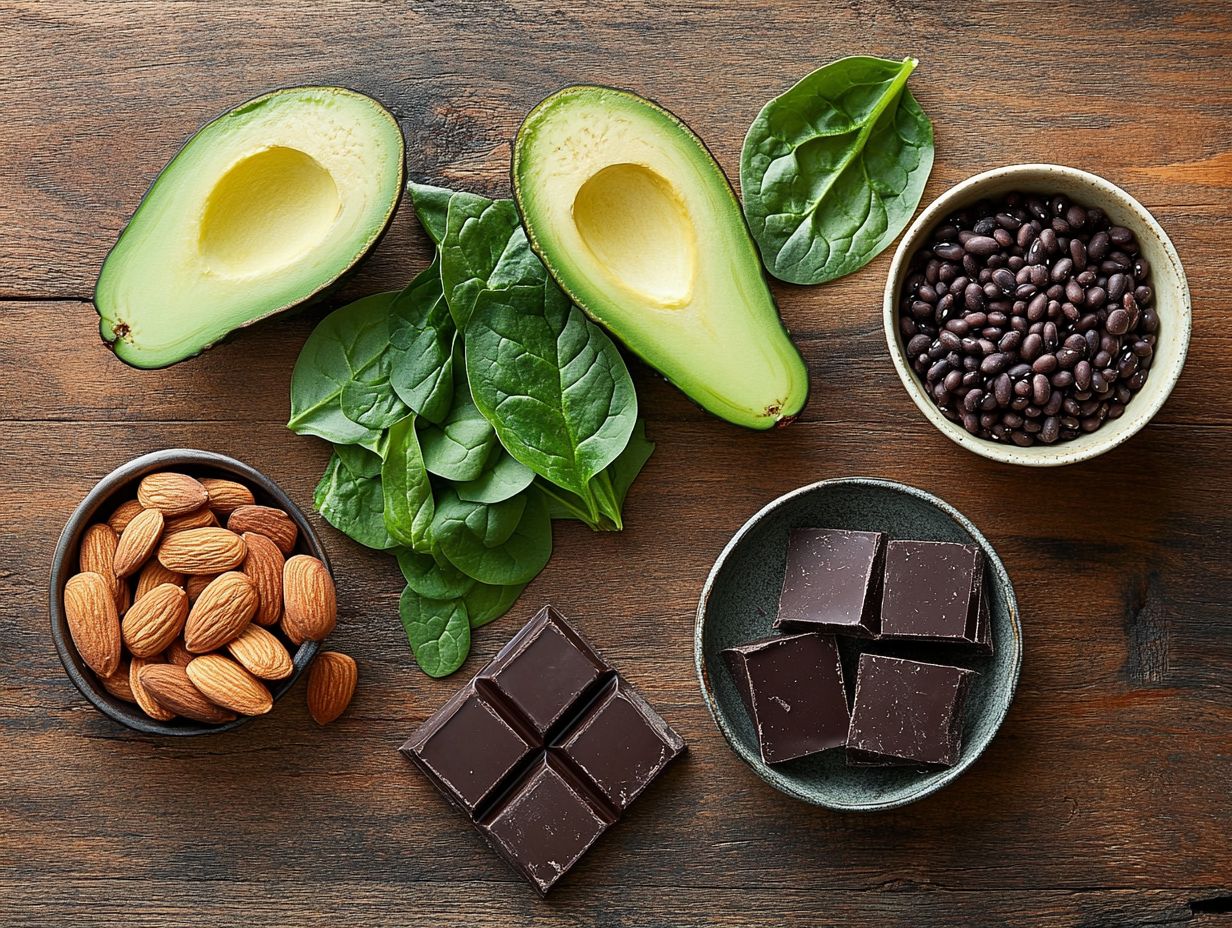
Incorporar alimentos ricos en magnesio en tu dieta puede ser tanto simple como agradable. Imagina esto: a adir un pu ado de nueces y semillas a tus batidos. O reemplazar tu habitual arroz blanco por quinoa, un grano delicioso que es rico en magnesio y proporciona prote na completa.
Para un impulso nutritivo, a ade algunas almendras o semillas de calabaza a tu yogur matutino. Es una manera encantadora de comenzar el d a.
Las verduras de hojas verdes como la espinaca pueden elevar tus comidas sin esfuerzo. Agr galas a ensaladas o m zclalas en batidos para facilitar el aumento de tu ingesta de magnesio.
Haz el cambio hoy mismo preparando comidas centradas en estos alimentos. Este enfoque no solo ayuda a vivir m s saludable, sino que tambi n nutre tu cuerpo y apoya tu salud en general.
What Are Some Other Ways to Boost Magnesium Levels?
Your diet is just the start. Embracing lifestyle changes such as regular exercise and effective stress management can significantly elevate your magnesium levels and enhance your overall well-being.
Incorporating activities like yoga or brisk walking promotes cardiovascular health. It also lifts your mood and reduces stress both vital for maintaining optimal magnesium levels.
Engaging in mindfulness practices, like meditation, helps regulate your stress hormones. This further bolsters your body s capacity to retain this essential mineral. Don’t underestimate the power of adequate sleep; restful nights are crucial for recovery and improved nutrient absorption.
Make small daily changes for better magnesium levels, and you’ll witness a noteworthy increase in your magnesium levels.
What Are the Best Sources of Magnesium for Vegetarians and Vegans?
For vegetarians and vegans, a wealth of plant-based magnesium sources awaits. These include legumes, nuts, seeds, and whole grains. This means que puede f cilmente cumplir con sus necesidades de magnesio sin depender de productos animales.
Incorporar estos alimentos a tus comidas diarias es sencillo y agradable. Por ejemplo, agrega un pu ado de espinacas o col rizada a tus batidos. Esto no solo aumenta tu ingesta de magnesio, sino que tambi n aporta vitaminas esenciales para energizar tu d a.
Cocinar con quinoa es otra excelente opci n. Es una prote na completa y est llena de magnesio, lo que la convierte en una adici n fant stica a ensaladas o como base nutritiva para tus vegetales favoritos.
Los frutos secos como las almendras y anacardos son deliciosos. Puedes disfrutarlos como snacks o espolvorearlos sobre avena para un toque crujiente. Las semillas, como las de calabaza o ch a, pueden mezclarse f cilmente en yogur o pancakes para mejorar su perfil nutricional.
Con un toque de creatividad en la cocina, puedes disfrutar de una variedad de sabores mientras cumples con tus necesidades diet ticas.
Can Supplements Be Used to Increase Magnesium Levels?
Los suplementos de magnesio pueden ser una forma muy efectiva de aumentar tus niveles de magnesio. Esto es especialmente til si te resulta dif cil obtener suficiente de tu dieta. Sin embargo, es esencial usarlos con precauci n debido al riesgo potencial de toxicidad.
Existen varios tipos de suplementos de magnesio en el mercado, como el citrato, glicinato y xido. Cada uno tiene diferentes niveles de efectividad y tasas de absorci n.
Si eres atleta, tienes una enfermedad cr nica, o est s lidiando con ansiedad, la suplementaci n puede ser especialmente beneficiosa. El magnesio es crucial para la funci n muscular, la transmisi n nerviosa y el bienestar general.
Es vital reconocer que el consumo excesivo puede llevar a efectos no deseados. Por ello, es imperativo consultar a un proveedor de atenci n m dica antes de incorporar estos suplementos en tu rutina. Con la orientaci n adecuada, puedes asegurarte de que los beneficios de la suplementaci n con magnesio superen cualquier riesgo potencial.
What Are the Benefits of Having Optimal Magnesium Levels?
Maintaining optimal magnesium levels brings a wealth of health benefits, including a reduced risk of heart disease and diabetes, improved mental health, and enhanced muscle function.
Research suggests that adequate magnesium intake may lead to lower blood pressure and better cholesterol profiles two critical factors for heart health.
A study published in the Journal of Nutrition even highlighted a link between magnesium levels and a decreased incidence of metabolic syndrome, a precursor to diabetes.
Registered dietitian Anna Taylor points out that magnesium is essential for regulating chemicals that help send messages in the brain, which can significantly influence your mood and anxiety levels.
This vital mineral also helps relax your muscles and aids recovery, making it particularly advantageous for athletes and anyone who engages in regular physical activity.
Getting enough magnesium is key to feeling your best!
Frequently Asked Questions
Want to know the best foods to boost your magnesium levels?
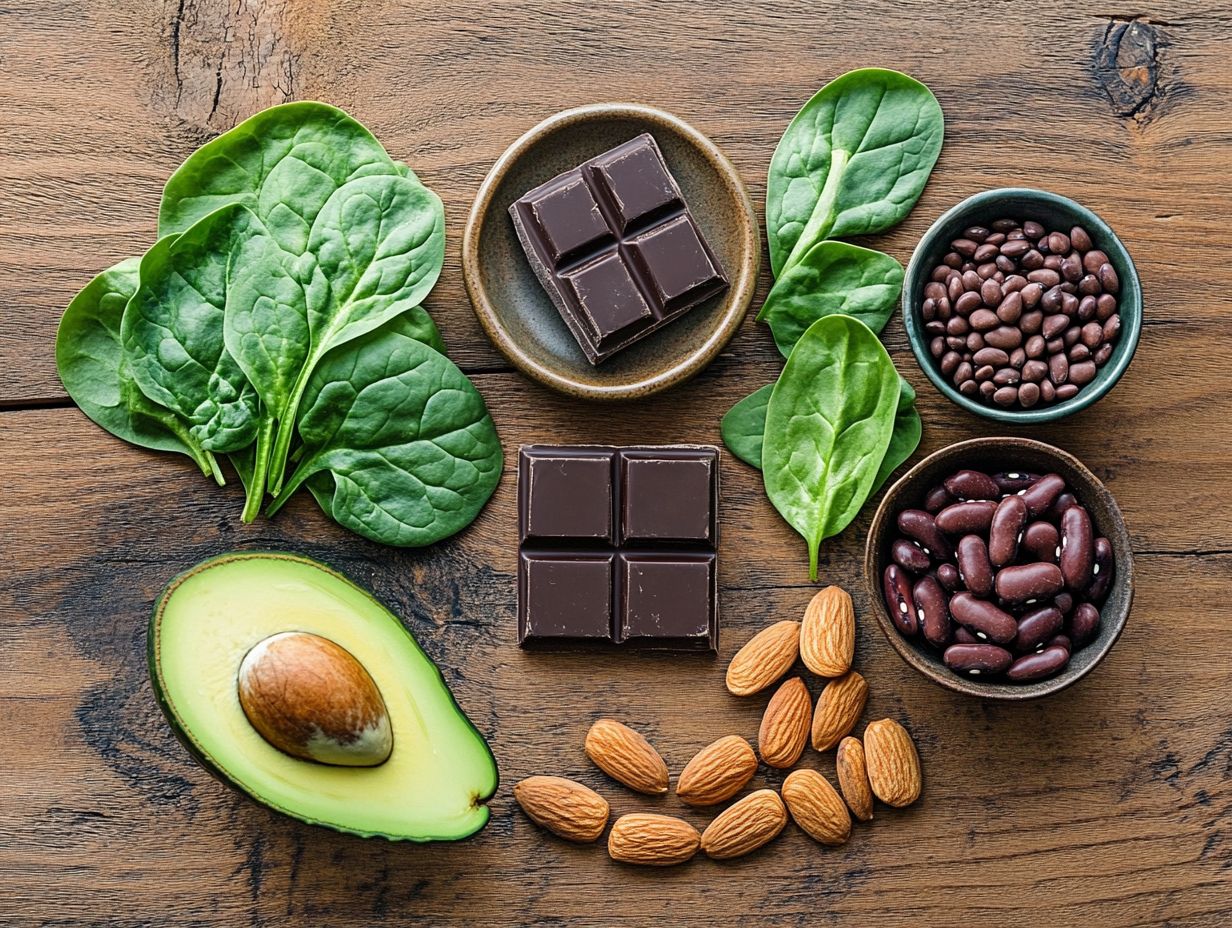
The top 5 foods for boosting your magnesium levels are dark leafy greens, nuts and seeds, whole grains, legumes, and fatty fish.
Why is magnesium important for our bodies?
Magnesium is an essential mineral that plays a crucial role in many bodily functions, including regulating muscle and nerve function, maintaining a healthy immune system, and supporting bone health.
How can a deficiency in magnesium affect our health?
A deficiency in magnesium can lead to fatigue, muscle cramps, mood changes, and even more severe conditions such as osteoporosis, heart disease, and diabetes.
What makes dark leafy greens a top food for boosting magnesium levels?
Dark leafy greens, such as spinach, kale, and Swiss chard, are rich in magnesium and other important nutrients. They also have a low calorie count, making them an excellent choice for a healthy diet.
Why are nuts and seeds recommended for increasing magnesium intake?
Nuts and seeds, such as almonds, cashews, pumpkin seeds, and sunflower seeds, are excellent sources of magnesium. They are also high in healthy fats, protein, and fiber, making them a filling and nutritious snack.
Can incorporating these foods into our diet provide enough magnesium on its own?
While adding these top 5 foods to your diet is an excellent way to boost your magnesium levels, it’s always best to consult with a healthcare professional to ensure you are meeting your specific daily magnesium needs.
Ready to make a change? Try incorporating magnesium-rich foods into your meals today!

